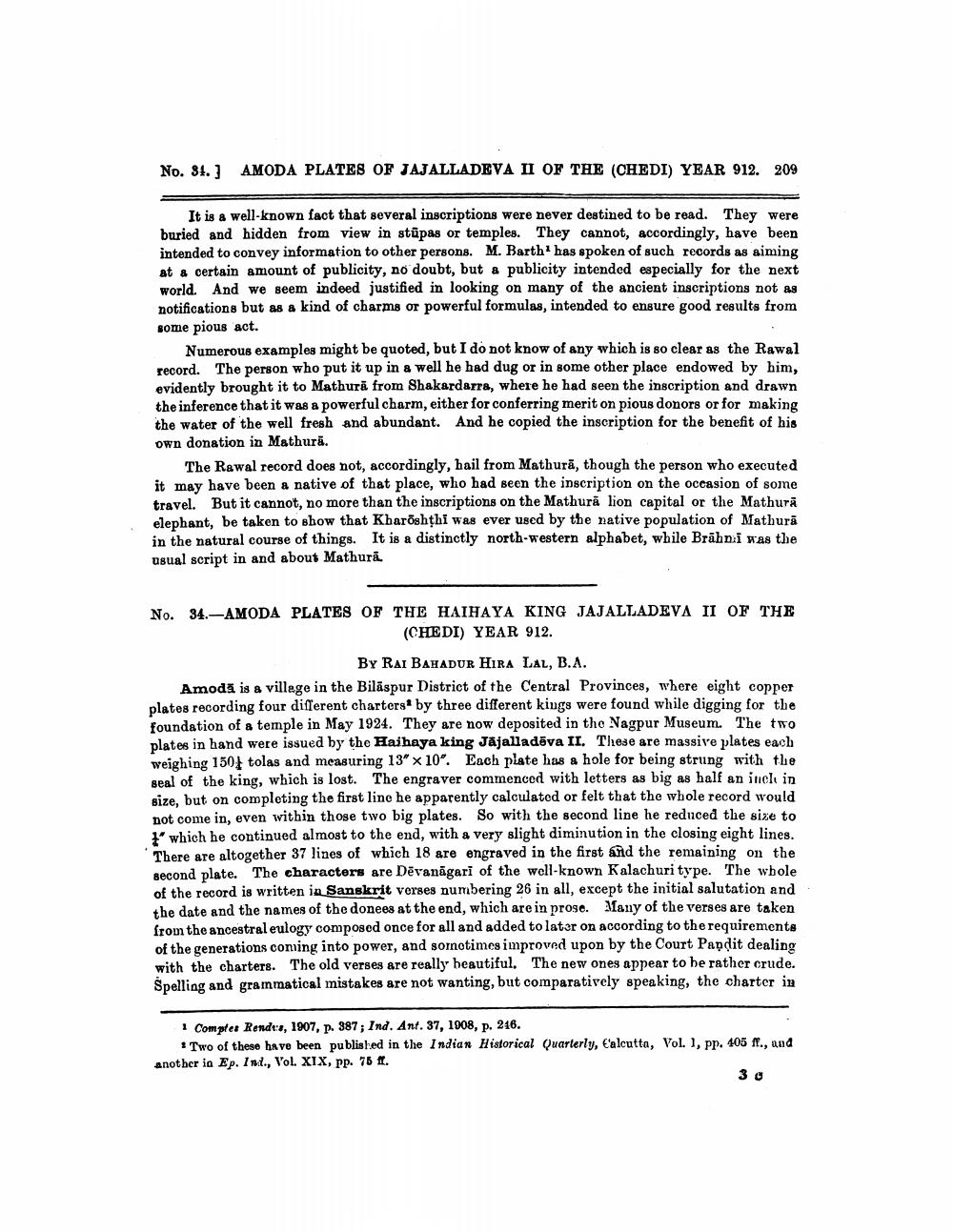________________
No. 31.] AMODA PLATES OF JAJALLADEVA II OF THE (CHEDI) YEAR 912. 209
It is a well-known fact that several inscriptions were never destined to be read. They were buried and hidden from view in stūpas or temples. They cannot, accordingly, have been intended to convey information to other persons. M. Barth1 has spoken of such records as aiming at a certain amount of publicity, no doubt, but a publicity intended especially for the next world. And we seem indeed justified in looking on many of the ancient inscriptions not as notifications but as a kind of charms or powerful formulas, intended to ensure good results from some pious act.
Numerous examples might be quoted, but I do not know of any which is so clear as the Rawal record. The person who put it up in a well he had dug or in some other place endowed by him, evidently brought it to Mathura from Shakardarra, where he had seen the inscription and drawn the inference that it was a powerful charm, either for conferring merit on pious donors or for making the water of the well fresh and abundant. And he copied the inscription for the benefit of his own donation in Mathura.
The Rawal record does not, accordingly, hail from Mathura, though the person who executed it may have been a native of that place, who had seen the inscription on the occasion of some travel. But it cannot, no more than the inscriptions on the Mathura lion capital or the Mathura elephant, be taken to show that Kharoshthi was ever used by the native population of Mathura in the natural course of things. It is a distinctly north-western alphabet, while Brahni was the usual script in and about Mathura.
No. 34.-AMODA PLATES OF THE HAIHAYA KING JAJALLADEVA II OF THE (CHEDI) YEAR 912.
BY RAI BAHADUR HIRA LAL, B.A.
Amoda is a village in the Bilaspur District of the Central Provinces, where eight copper plates recording four different charters by three different kings were found while digging for the foundation of a temple in May 1924. They are now deposited in the Nagpur Museum. The two plates in hand were issued by the Haihaya king Jäjalladeva II. These are massive plates each weighing 150 tolas and measuring 13" x 10". Each plate has a hole for being strung with the seal of the king, which is lost. The engraver commenced with letters as big as half an incl in size, but on completing the first line he apparently calculated or felt that the whole record would not come in, even within those two big plates. So with the second line he reduced the size to
which he continued almost to the end, with a very slight diminution in the closing eight lines. There are altogether 37 lines of which 18 are engraved in the first and the remaining on the second plate. The characters are Devanagari of the well-known Kalachuri type. The whole of the record is written in Sanskrit verses numbering 26 in all, except the initial salutation and the date and the names of the donees at the end, which are in prose. Many of the verses are taken from the ancestral eulogy composed once for all and added to later on according to the requirements of the generations coming into power, and sometimes improved upon by the Court Pandit dealing with the charters. The old verses are really beautiful. The new ones appear to be rather crude. Spelling and grammatical mistakes are not wanting, but comparatively speaking, the charter in
1 Comptes Rendts, 1907, p. 387; Ind. Ant. 37, 1908, p. 246.
Two of these have been published in the Indian Historical Quarterly, Calcutta, Vol. 1, pp. 405 ff., and another in Ep. Ind., Vol. XIX, pp. 75 ff.
30




